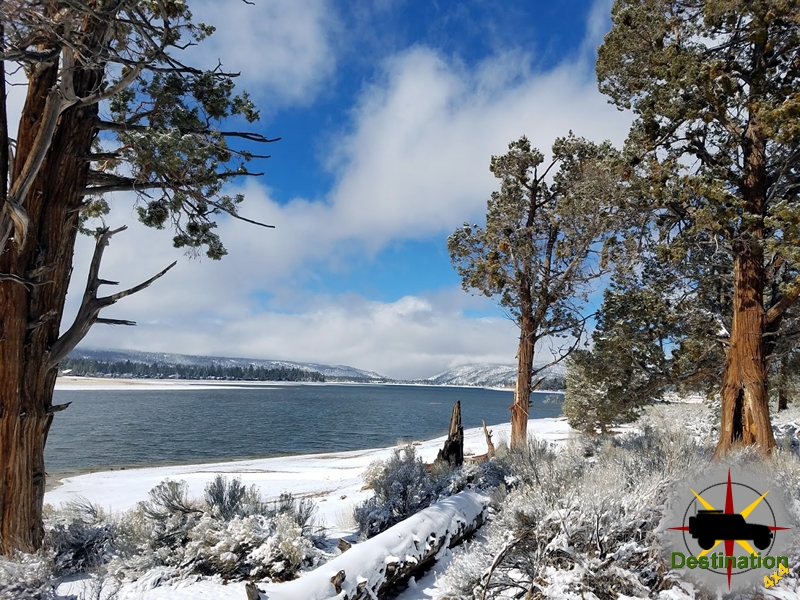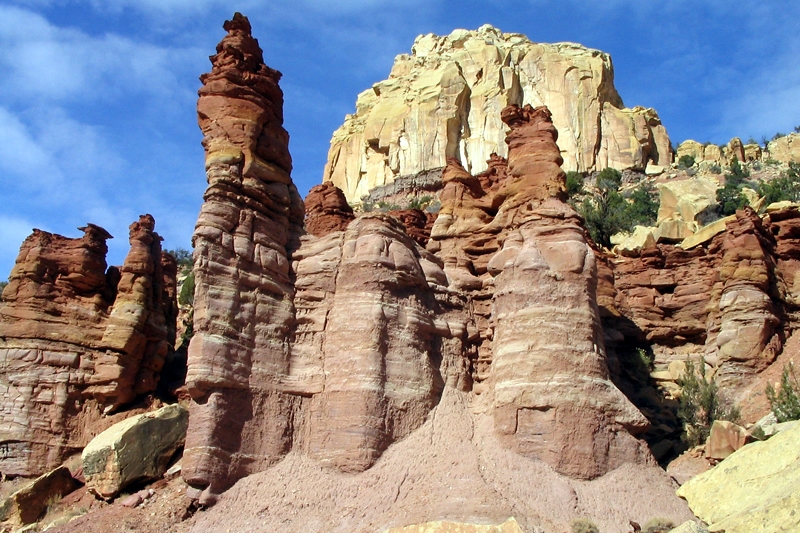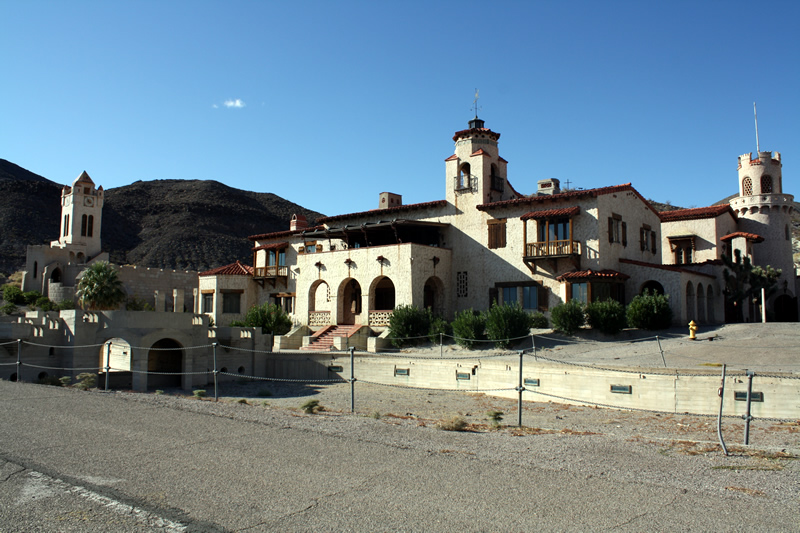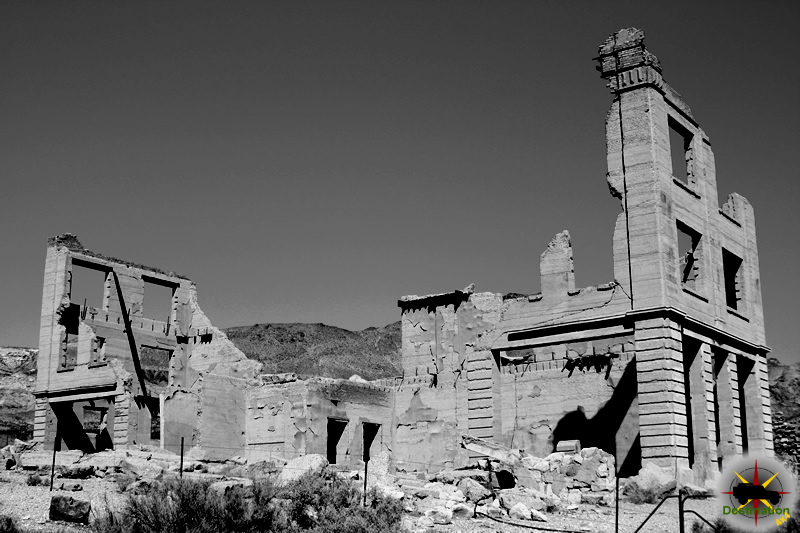
Old Spanish Trail (Journey of the Dead Man)
Old Spanish Trail (Journey of the Dead Man) is a Nevada State Historic Marker Number 139 located in Clark County, Nevada. This marker is one of several which tell the history of the Old Spanish Trail in Nevada.
The Old Spanish Trail is a 700 mile long historical trade route that connected the northern New Mexico settlements near Santa Fe, New Mexico with those of Los Angeles, California. The trail’s rugged terrain discouraged the use of wagons. It was always a pack route, mainly used by men and mules.
The routes and trails link California, Nevada, Arizona, Utah and Colorado. The Old Spanish Trail consists of a series and different trails and routes some of which are in service today.

Nevada State Historical Markers identify significant places of interest in Nevada’s history. The Nevada State Legislature started the program in 1967 to bring the state’s heritage to the public’s attention with on-site markers. These roadside markers bring attention to the places, people, and events that make up Nevada’s heritage. They are as diverse as the counties they are located within and range from the typical mining boom and bust town to the largest and most accessible petroglyph sites in Northern Nevada Budget cuts to the program caused the program to become dormant in 2009. Many of the markers are lost or damaged.
Nevada State Historic Marker 139 Text
Early Spanish traders named the fifty-five dry miles separating Las Vegas and the Muddy River the Journada Del Muerto (Journey of The Dead Man). This longest stretch without water along the Old Spanish Trail was littered with the skeletons of animals and parts of wagons abandoned along the sandy desert. Most experienced travelers made the trip at night.
John C. Frémont crossed the Journada in 1844 and commented: “We ate the barrel cactus and moistened our mouths with the acid of the sour dock. Hourly expecting to find water, we continued to press on to midnight, when after a hard and uninterrupted march of 16 hours, our wild mules began running ahead; and in a mile or two we came to a bold running stream (the Muddy River).”
STATE HISTORICAL MARKER No. 139
STATE HISTORIC PRESERVATION OFFICE
Nevada State Historic Marker 139 Map
Nevada State Historic Marker Number 139 is located off Interstate 15 north of Las Vegas. The marker is located about 1/4 mile south of the I-15 in Nevada State Route 169.
Nevada State Historic Marker 139 Summary
| Name | Old Spanish Trail (Journey of the Dead Man) |
| Location | Clark County, Nevada |
| Nevada State Historic Marker | 138 |
| Latitude, Longitude | 36.5010, -114.7605 |
References
Death Valley Railroad
The Death Valley Railroad (DVRR) was a historic 3 ft (914 mm) narrow-gauge railroad that once operated in Death Valley. Built primarily to support mining operations in the remote and harsh terrains of the Death Valley region, it played a crucial role in the economic development of the area during the late 19th and early 20th centuries. The line started in Death Valley Junction, CA and followed the modern California State Route 190 down the the mining camp of Ryan.

Early Days and Construction
The idea of constructing a railroad in the inhospitable terrain of Death Valley emerged during the late 19th century with the discovery of various valuable mineral deposits. Initially, the isolated mining communities were heavily dependent on mule teams and wagons for transportation, which was both slow and inefficient.
In 1904, the Pacific Coast Borax Company, recognizing the need for a more efficient transportation system, began the construction of the Death Valley Railroad. The railway was intended to connect the mining towns of Ryan, near Death Valley, to the Tonopah and Tidewater Railroad, which served the wider region.

Development and Operations
The construction of the railroad faced immense challenges due to the rugged landscape, extreme weather conditions, and the scarcity of resources in the area. The laborers encountered difficulties such as intense heat, lack of water, and treacherous terrain, but despite these challenges, the construction continued.
By 1914, the DVRR was fully operational, enabling the efficient transportation of borax, gold, silver, and other minerals from the mines to the broader market. The railroad significantly reduced transportation costs and facilitated the growth of mining operations in the area.

One train ran each day delivering food and water to the workers at the Ryan mine in the mourning. The same train bought ore back late in the afternoon. After better deposits of borax were discovered at Boron, the Death Valley Railroad tried to resort to tourist operations by bringing in a Brill railcar to transport tourists to the old mines which made up Furnace Creek. A Brill car is a self propelled gasoline rail vehicle.
California State Route 190 roughly follows the route of this railroad.
Decline and Closure
Eventually, with the Great Depression of the 1930s and the increased usage of automobiles and trucks for transportation. The narrow gage D V R R ceased its operations in 1931. The tracks were removed, and much of the equipment was sold off or abandoned, marking the end of an era for the railroad and the mining communities it had served.
Although the Death Valley Railroad’s existence was relatively short-lived, it played a pivotal role in the development of the Death Valley region, contributing significantly to the growth of the mining industry and the economic prosperity of the local communities during its operation. Today, remnants of the railroad’s route can still be found in the Death Valley National Park, serving as a testament to its historical significance and the challenges faced by early industrial pioneers in this unforgiving landscape.






Death Valley Railroad Summary
| Name | Death Valley Railroad |
| Location | Nye County, Nevada Death Valley, California |
| Gage | Narrow Gage, 3 ft (914mm) |
| Length | 25 Miles |
| Years of Operation | 1914 – 1931 |
Death Valley Railroad Locomotives
| Locomotive | Manufacturer | Service | |
| Heisler #2 “Francis” | 2-Truck | Stearns Manufacturing Locomotive Works | 1899 – 1925 |
| Baldwin DVRR No 1 | 2-8-0 | Baldwin Locomotive Works | |
| Baldwin DVRR No 2 | 2-8-0 | Baldwin Locomotive Works | 1916 – |
References
Devil’s Gate – Nevada State Historic Marker 223
Devil’s Gate, located in Lyon County, Nevada, is a striking natural landmark renowned for its rugged and otherworldly beauty. The geologic landmark is recognized as Nevada State Historic Marker number 223. Devil’s Gate is an impressive rock formation located along Nevada State Route 342 outside of Silver City, Nevada. The gate to Gold Canyon was carved by the forces of nature over thousands of years.

Nevada State Historic Marker 223
Nevada State Historical Markers identify significant places of interest in Nevada’s history. The Nevada State Legislature started the program in 1967 to bring the state’s heritage to the public’s attention with on-site markers. These roadside markers bring attention to the places, people, and events that make up Nevada’s heritage. They are as diverse as the counties they are located within and range from the typical mining boom and bust town to the largest and most accessible petroglyph sites in Northern Nevada Budget cuts to the program caused the program to become dormant in 2009. Many of the markers are lost or damaged.
It gives … “a forcible impression of the unhallowed character of the place.” J. Ross Browne . 1860
This rugged reef of metamorphic rock was once one of the famous landmarks of the Nevada Territory. In June of 1850, John Orr and Nicholas Kelly unearthed a gold nugget nearby, the first ever found in Gold Canyon. For the next ten years, the can was the scene of placer mining and one of the first stamp mills in the Territory was erected just to the south of Devil’s Gate during the summer of 1860.
During the brief Paiute War of May, 1860, the people of Silver City built a stone battlement atop the eastern summit and constructed a wooden cannon for protection.
Devil’s Gate marks the boundary line between Storey and Lyon Counties. Through this narrow gorge paraded thousands of the most adventurous souls of the mining West as they made their way to the gold and silver mines of the Comstock Lode.
STATE HISTORICAL MARKER No. 223
DIVISION OFHISTORIC PRESERVATION AND ARCHAEOLOGY
SPONSORED BY:
RENO CHAPTER OF THE NATIONAL SOCIETY
DAUGHTERS OF THE AMERICAN COLONISTS
Devil’s Gate Historic Marker Map
Nevada State Historic Marker number two hundred twenty three is location on the western side of Nevada State Route near the geologic feature. The marker is just north of Silver City, Nevada.

Nevada State Historic Marker Summary
| Name | Devil’s Gate |
| Location | Lyon County, Nevada |
| Latitude, Longitude | 39.2667, -119.6419 |
| GNIS | 222304 |
| Nevada State Historic Marker | 223 |
References
Gypsum Cave – Nevada State Historical Marker 103

Gypsum Cave, located in the Mojave Desert of Clark County, Nevada and the subject of Nevada State Historic Marker number 103. The cave system is a significant archaeological site known for its rich history and diverse ecological significance. The dry, cool air within the cave allowed for the mummification of Pleistocene fossils and most notably soft tissue, hair, and dung. The mummification process of this material allowed for the preservation of DNA from over 11,000 years ago. The cave has garnered attention from both scientists and archaeologists due to its well-preserved ancient artifacts and evidence of prehistoric human occupation.
Geological Features
Gypsum Cave is characterized by its unique geology, primarily comprising gypsum deposits. The cave formation is attributed to the dissolution of gypsum by water, leading to the creation of intricate patterns and formations within the cave. These formations include stalactites, stalagmites, and gypsum flowers, contributing to the aesthetic appeal and scientific interest of the cave.
Historical Significance
The cave holds immense historical significance due to its association with the ancient inhabitants of the region. Archaeological excavations have revealed evidence of human occupation dating back to the prehistoric era. The discovery of well-preserved artifacts, such as stone tools, hearths, and rock art, has provided valuable insights into the lifestyles and cultural practices of the early inhabitants, including the Paleo-Indians and the Ancient Puebloans.
Ecological Importance
Apart from its archaeological value, Gypsum Cave also supports unique ecological communities. The cave ecosystem sustains various species of microorganisms, insects, and small mammals adapted to the cave environment. Additionally, the surrounding Mojave Desert landscape harbors a diverse range of plant and animal species, contributing to the overall biodiversity of the region.

Presently, ongoing research initiatives focus on further exploring the archaeological remains within Gypsum Cave to deepen our understanding of the early human presence in the area. The preservation of the cave’s delicate ecosystem and archaeological resources remains a key priority for conservation efforts. Collaborative measures involving government agencies, local communities, and research institutions aim to establish sustainable preservation strategies while promoting responsible tourism and public education about the cave’s significance.
Gypsum Cave stands as a testament to the rich history and geological diversity of the Nevada region. Its unique blend of geological formations, historical artifacts, and ecological significance continues to inspire scientific inquiry and foster a deeper appreciation for the cultural heritage and natural wonders of the area. Continued efforts to preserve and study Gypsum Cave will contribute to our understanding of early human civilizations and the intricate balance of ecosystems within cave environments.
Nevada State Historic Marker Location
Nevada State Historic Marker 103 Text
Nevada State Historical Markers identify significant places of interest in Nevada’s history. The Nevada State Legislature started the program in 1967 to bring the state’s heritage to the public’s attention with on-site markers. These roadside markers bring attention to the places, people, and events that make up Nevada’s heritage. They are as diverse as the counties they are located within and range from the typical mining boom and bust town to the largest and most accessible petroglyph sites in Northern Nevada Budget cuts to the program caused the program to become dormant in 2009. Many of the markers are lost or damaged.
Gypsum Cave was once thought to be one of the oldest aboriginal sites in North America. The cave is 300 feet long and 120 feet wide and is filled with dry, dusty deposits in all six rooms.
When excavated in 1930-31, the cave yielded the skull, backbone, nine to twelve-inch claws, reddish-brown hair and fibrous dung of the giant ground sloth, a vegetarian species common in the more moist environment known here about 7,500 to 9,500 years ago. Bones from extinct forms of the horse and camel were also found.
Pieces of painted dart shafts, torches, stone points, yucca fiber string and other artifacts were found mixed in with the sloth dung. When the dung was dated at 8,500 B.C. by the radiocarbon method, it was believed the man-made tools were the same age. Two radiocarbon dates on the artifacts themselves, however, indicate that the ground sloth and man were not contemporaneous inhabitants of the cave. Man probably made use of the cave beginning about 3,000 B.C., long after the ground sloths had abandoned it.
Nevada State Historic Marker Summary
| Name | The Gypsum Cave |
| Location | Clark County, Nevada |
| Latitude, Longitude | 36.2318, -114.8829 |
| Nevada State Historic Marker Number | 103, Marker is missing |
| National Register of Historic Places | 10000443 |
References
The Camel Corps – Nevada State Historic Marker 104
Nevada State Historic Marker no 104 is The Camel Corps located in Clark County Nevada along highway 163 near Laughlin. Sadly, according to the Historic Markers Database the marker is reported missing. The marker was originally installed around mile maker number eight.

The use of camels in the American West during the mid-19th century is a little-known but fascinating aspect of the region’s history. The Camel Corps in Nevada was a part of this larger story, involving the introduction of camels to the desert landscape of Nevada and their brief but impactful role in supporting westward expansion, military operations, and transportation in the arid state.
The idea of using camels in the American West can be traced back to Major George H Crossman in 1836, when explorers and military officers recognized the need for more suitable pack animals to traverse the vast, arid landscapes. Camels, with their ability to carry heavy loads over long distances and thrive in desert conditions, seemed like a logical choice. In 1855, U.S. Army Major Henry C. Wayne officially introduced camels to the American West through the U.S. Camel Corps, often referred to as the “Red Ghost” for its emblem.
In 1857, Edward F. Beale, a U.S. Navy officer and explorer, introduced the camels to Nevada as part of a surveying expedition. Beale and his team crossed Nevada, primarily along the 35th parallel, using camels as pack animals and for transportation. These camels successfully carried supplies and equipment across the state’s harsh deserts and mountain ranges, demonstrating their suitability for such conditions.
The outbreak of the American Civil War in 1861 disrupted the Camel Corps’s operations, as military resources were redirected to the conflict in the East. During the war, some camels were used in the southwestern United States for various purposes, but the Camel Corps was largely disbanded.
Although the Camel Corps was relatively short-lived, its impact on Nevada and the American West was significant. The camels helped explore and open up vast areas that were previously considered too inhospitable for travel, including parts of Nevada. They proved their worth in the arid regions of the state, and their presence during this period is remembered in various anecdotes and local legends.
One of the most famous stories is that of the “Red Ghost,” a feral camel that roamed the Nevada deserts for years after the disbandment of the Camel Corps. This camel, thought to be an escapee from the corps, became the subject of numerous sightings and legends.
The Camel Corps in Nevada, although a short-lived experiment, left an enduring mark on the history of the American West. The use of camels in the state demonstrated the adaptability of these animals to the harsh desert environments and contributed to the opening of previously inaccessible regions. Though the Camel Corps was eventually disbanded and camels largely faded from use in the West, their legacy lives on in the stories and legends of Nevada, reminding us of the innovative and adventurous spirit of those who sought to conquer the American frontier.
Nevada State Historic Marker 104 Text
Nevada State Historical Markers identify significant places of interest in Nevada’s history. The Nevada State Legislature started the program in 1967 to bring the state’s heritage to the public’s attention with on-site markers. These roadside markers bring attention to the places, people, and events that make up Nevada’s heritage. They are as diverse as the counties they are located within and range from the typical mining boom and bust town to the largest and most accessible petroglyph sites in Northern Nevada Budget cuts to the program caused the program to become dormant in 2009. Many of the markers are lost or damaged.
In 1855, Congress authorized $30,000.00 for camels as frontier military beasts of burden because of their adaptability to desert heat, drought, and food.
Lt. Edward F. Beale surveyed the wagon route from Fort Defiance, New Mexico, to the Colorado River near the tip of present-day Nevada, testing the fitness of these camels. They crossed the Colorado River into what is today Nevada, north to Fort Mohave, October 18, 1857.
The experiment was not practical, but several of Beale’s camels hauled commercial freight from Sacramento to the Nevada territory. Others carried salt, ore, and supplies through central Nevada.
Careless treatment, domestic stock incompatibility and new transportation methods ended use of camels. Some were reportedly seen years later wandering in southwest deserts, making them a fixture of western folklore.
STATE HISTORICAL MARKER No. 104
STATE HISTORIC PRESERVATION OFFICE
Nevada State Historic Marker 104 Map
Historic Marker Summary
| Name | The Camel Corps |
| Location | Clark County, Nevada |
| Latitude, Longitude | 35.1714, -114.7108 |
| Nevada State Historic Marker Number | 104 |



